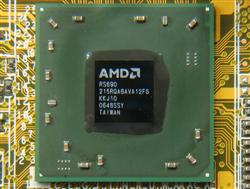 18
18
AMD 690 Chipset Series Preview Review
HDMI 1.3 & Gaming Performance »Introduction

With the AMD and ATI merger on October 25th 2006, two giant companies of very different areas came together and many were worried about the future of the ATI brand. Over the last few months it has become more than apparent that the brand will live on, but some were concerned about the future mainboard chipsets. While NVIDIA has had a firm grip on the chipset market for some time, offering both AMD and Intel based solutions, there is a new guy in town. AMD is launching the first chipset that was created under the AMD/ATI brand, called the 690 chipset. The chipset is fully featured and there two variants. Both use the same silicon, but certain features are simply disabled, the Southbridge can be chosen by the motherboard manufacturer, with the AMD SB600 the best choice. The two variants are AMD 690G and 690V.
As you can see, the Northbridge chip itself is quite small and can easily be passively cooled. It has a heat output of approximately 7 Watts, which makes it a good choice for notebook platforms as well. The chipset includes a lot of features on-die, without the use of any external chips or controllers. This reduces the overall price of a mainboard, as there is no need to buy separate chips for HDMI, for example. The AMD 690 costs a mere $15 USD for motherboard makers, which helps keep the board price down. The integrated ATI Radeon X1250 GPU can handle games much better than any previous on-board graphics card, it is comparable to a Radeon 9700 in performance. Using FSAA and AA with the X1250 is certainly a possibility. AMD has also focused on avoiding a driver mess and delivers support for the X1250 with the proven Catalyst Driver Suite. A unified driver is used for all integrated, mobile and discrete graphics which makes it much easier for users to find the right driver - there is only one.
The chipset is not only the first joint AMD and ATI product, but there are a few new mainboard manufacturers producing boards using an AMD based chips for the first time. Biostar, Foxconn and Gigabyte will be joining the long list of manufacturers to produce boards on AMD chipsets.
AMD 690 Variants
As mentioned before, there are two variants of the AMD 690 - the 690G and 690V. The difference between them is twofold. The 690G is fully featured, with HDMI & DVI output named Radeon XPress 1250, while the 690V lacks HDMI or DVI by using a D-Sub VGA output with simple TV-Out and therefore features a Radeon XPress 1200 GPU. The ATI Radeon X1200-family IGP has two pixel-pipelines and two vertex-shaders. AMD specifies the GPU to run at 400 MHz. While this may not sound like much, it is faster than any integrated solution that NVIDIA or Intel have to offer. The video memory is shared with the motherboard's main memory, which means that a portion (32 MB to 256 MB) can be allocated by the BIOS for video use only.While the focus is on highly integrated desktop parts, the AMD 690G will also be available in Notebooks and will be called the M690G. There is no physical difference between the 690G and the M690G. The M690G can be paired with a small DRAM chip on-board, which stores the VGA frame buffer. This lets the IGP go into a deeper sleep state because video memory does not need to be refreshed. Such a small features can add up to 20 minutes of battery life. This power saving feature can only be activated while 2D Windows is active, because it saves only what is displayed on your screen, not textures or geometry.
Let's take a look at the overall features.
Apr 22nd, 2025 16:02 CDT
change timezone
Latest GPU Drivers
New Forum Posts
- What are you playing? (23427)
- New Pc audio & video. (1)
- Are the 8 GB cards worth it? (11)
- Mouse battery + Front mouse buttons don't want to work. (0)
- 5060 Ti 8GB DOA (172)
- RX 9000 series GPU Owners Club (464)
- [Test Build] Fix for 576.02 Driver Install (49)
- 48GB DDR5 ECC SODIMM modules with i9-12950HX (HP Zbook Fury G9) (2)
- Can you guess Which game it is? (74)
- Spoofer Modified SMBIOS/BIOS – Need Help Restoring Original Motherboard Info (TUF GAMING B550-PLUS WiFi II) (6)
Popular Reviews
- ASRock X870E Taichi Lite Review
- ASUS GeForce RTX 5060 Ti TUF OC 16 GB Review
- NVIDIA GeForce RTX 5060 Ti PCI-Express x8 Scaling
- Palit GeForce RTX 5060 Ti Infinity 3 16 GB Review
- Sapphire Radeon RX 9070 XT Pulse Review
- MSI GeForce RTX 5060 Ti Gaming OC 16 GB Review
- Upcoming Hardware Launches 2025 (Updated Apr 2025)
- Sapphire Radeon RX 9070 XT Nitro+ Review - Beating NVIDIA
- Teevolution Terra Pro Review
- ASUS GeForce RTX 5060 Ti Prime OC 16 GB Review
Controversial News Posts
- NVIDIA GeForce RTX 5060 Ti 16 GB SKU Likely Launching at $499, According to Supply Chain Leak (182)
- NVIDIA Sends MSRP Numbers to Partners: GeForce RTX 5060 Ti 8 GB at $379, RTX 5060 Ti 16 GB at $429 (127)
- NVIDIA Launches GeForce RTX 5060 Series, Beginning with RTX 5060 Ti This Week (115)
- Nintendo Confirms That Switch 2 Joy-Cons Will Not Utilize Hall Effect Stick Technology (105)
- Nintendo Switch 2 Launches June 5 at $449.99 with New Hardware and Games (99)
- Sony Increases the PS5 Pricing in EMEA and ANZ by Around 25 Percent (85)
- NVIDIA PhysX and Flow Made Fully Open-Source (77)
- Windows Notepad Gets Microsoft Copilot Integration (75)

